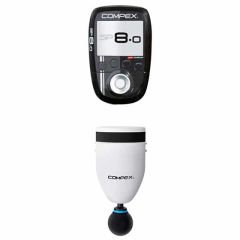How to Treat IT Band Syndrome with Electrostimulation

To those familiar with the IT band, you'll know that it is an area that can get very tight and, in turn, restrict movements. In this article we'll tell you how to identify IT band syndrome and tackle it effectively using electrostimulation.
What is IT Band Syndrome?
IT Band Syndrome, or Iliotibial Band Syndrome, is a common problem for long distance runners. It is a fibrous band, similar to a long tendon, located on the outer side of the thigh, extending from the hip to the knee. With each stride, this "cord" moves back and forth, much like a windscreen wiper, creating friction between the tendinous band and the bony part of the femur in contact with it.
Eliminating Possible Causes
IT Band Syndrome is one of the overuse injuries that can occur in any runner. However, this injury can have internal causes, specific to the runner (knee, foot, hip problems, etc.), or external causes (training content, shoes, etc.). In any case, it is necessary to consult a doctor who can conduct a full assessment and propose the best measures to address the problem.
This injury, like most tendinous conditions, usually has two phases, for which the Compex should not be used in the same way.

Using Compex Electrostimulation to treat acute IT Band Syndrome
During the first phase of IT Band Syndrome, which is the acute phase where the pain is severe and makes running impossible, the TENS Pain Relief program is advised.
Program:
- TENS Pain Relief
Cycle Duration:
- Repeat sessions as needed according to pain levels during the first few days, when rest from sports is generally required.
Session Frequency:
- Multiple sessions per day and/or consecutively are possible.
Electrode Placement:
- Cover the entire surface of the painful area with as many electrodes as necessary.
Position:
- Seated or lying down in a comfortable position.
Intensity Adjustment:
- Desired effect: Achieve a pronounced tingling sensation that is not painful.
- For devices without mi-TENS technology, slowly increase stimulation until a well-pronounced tingling sensation is felt. You can reduce intensity if muscle contractions occur.
- For devices with mi-TENS technology, the optimal stimulation intensity zone is automatically regulated to avoid any muscle contractions. On SP 4.0 and SP 8.0, if the intensity is too high, causing an contraction, the device will automatically lower the intensity.

Using Compex Electrostimulation to treat chronic IT Band Syndrome
The second phase follows the acute phase, where the pain from IT band syndrome is lower but hasn't disappeared completely. Use the Tendinitis (or Chronic Pain or Chronic Tendinitis) program during this stage. This type of stimulation will activate blood circulation in the tendinous band through the stimulation of muscles attached to the hip at the band (gluteus maximus and tensor fasciae latae).
Program:
- Tendinitis (or Chronic Pain or Chronic Tendinitis)
Cycle Duration:
- A daily session is necessary, ideally two sessions with sufficient rest between them. One session in the morning and another in the late afternoon represents optimal use.
- When training resumes at this stage, gradually increase intensity, favor running on soft terrain, and avoid pushing through if pain reappears significantly.
Electrode Placement:
- Place the electrodes away from the painful area to ensure better vascularisation of the affected structure.
Position:
- In the most comfortable, neutral position.
Intensity Adjustment:
- Desired effect: Achieve well-pronounced but comfortable muscle twitches.
- Increase the intensity until achieving a muscle response that resembles a pulse or strong vibration, called muscle twitches. This muscle activity behaves like a pump, significantly increasing blood flow in the stimulated muscle, helping to relieve IT band syndrome. Increasing the intensity makes the muscle twitch more pronounced until it reaches a maximum response.
- The screen indicates the optimal stimulation intensity zone for devices with mi-RANGE technology.
- On SP 4.0, a small hook indicates the optimal zone. Keep the intensity within the hook and, if possible, at its maximum level.
- On Fit 5.0 and SP 6.0, increase the intensity until "Optimal intensity level found" is displayed. If the stimulation is comfortable, you can increase the intensity slightly for more pronounced twitches.
- On SP 8.0, the mi-AUTORANGE function will automatically adjust the intensity. The device will display "Optimal intensity level found" once it finds the optimal intensity. If the stimulation is comfortable, you can increase the intensity slightly for more pronounced twitches.
Do not ignore pain. Consult a doctor if you experience pronounced and/or persistent pain.

Proven Effectiveness
Backed by clinical studies proving their effectiveness, Compex stimulators also belong to the category of Class II medical devices. They also meet the needs of the European Medical Standard 93/42 EEC.
Compex - Always with you
We're on the side of athletes, amateurs and also ordinary people, from the search for better performance to post injury recovery, from post fatigue massage to pain treatment. At Compex, we have just one goal: people's well being.
Choose the one that's right for you, by taking a look at our buying guide.
Read our experts' advice on the official blog, catch the latest news, product releases and promotions by subscribing to our newsletter, and watch our videos on the YouTube channel and follow us on Facebook and Instagram to stay up to date.








